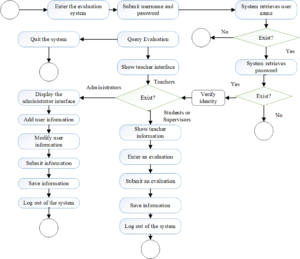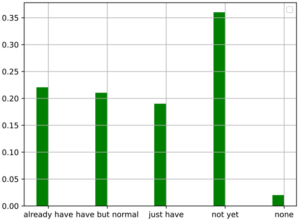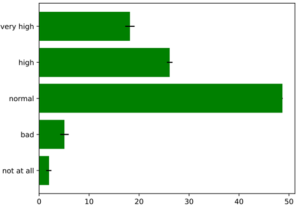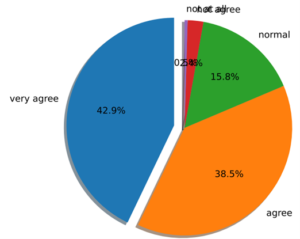With the support of large-scale information technology, education assessment no longer aims at the administration of the education system and the decision-making needs of educational institutions as before, but can serve all groups or people who are interested in and participate in education. The pertinence and effectiveness of students’ ideological and political education can be improved based on the analysis of data. As political educators in colleges and universities, they must keep pace with the times, actively analyze the students’ thoughts and behaviors with BDA, so that students have reason to make decisions on ideological and political education, so as to improve the pertinence and effectiveness of students’ political education and serve students to become talents. Therefore, based on the students’ political network, this paper puts forward a wide range of methods and analysis. The results show that our method can effectively promote the evaluation of students’ political education.
Since the establishment of the discipline of I&P education in 1984, the construction of science and technology has optimized the development of the discipline system, matured the development of discipline theory, and achieved gratifying results [1]. China’s relevant information network research has made some theoretical achievements, but there are few relevant research data under the conditions of the big era. This paper discusses the development of Internet students’ I&P education theory from the perspective of multi-disciplinary comprehensive research such as communication, management, psychology, pedagogy, sociology, ethics and informatics. BD can also promote the innovation of students’ Online I&P education theory and further improve the application of students’ Online I&P education theory in work practice [2,3].
The Internet, cloud computing, BD APP and other platforms have brought a world-integrated open cyberspace to the network social life, which in essence has changed people’s living condition, interaction mode and development conditions. Teachers use WeChat public number, QQ, Jitterbug, “Eban” and other online interactive platforms to grasp the evaluation methods of college students’ online communication [4,5]. The use of BD can also intervene in the teaching of catechism, play a role in assisting schools to ensure teaching, for example, through BD technology to capture the age, personality, behavior, trajectory and other characteristics of college students, and to effectively guide the ideological behavior of college students [6,7].
The implementation of the course affects the monitoring of the whole process of teaching the course plays a decisive consequence [8,9]. Teaching evaluation is a process of systematic investigation of teaching activities based on teaching objectives and making judgments about the degree of goal achievement as well as providing services. To carry out the evaluation of the quality situation of the course requires an objective, quantifiable and visible one evaluation system. Generally speaking, teaching evaluation consists of four steps: setting evaluation objectives, developing evaluation criteria, collecting information extensively and making judgments and attributions based on the criteria, and correcting teaching activities, therefore, teaching evaluation plays a qualitative leap to enhance curriculum evaluation [10]. The function and role of teaching evaluation are organically combined, and the function of evaluation is the premise of the role, while the role of assessment is the concrete performance of the function [11,12].
The I&P education is an important part of implementing the fundamental task of moral education. As a college ideological education worker, we should recognize the challenges and values of I&P education according to the characteristics of the development of the times and the changes in students’ thoughts [13].
This paper starts from the concept, characteristics and essence of BD, and finally improves the understanding of BD and updates I&P education using the idea of database, by establishing the evaluation system of I&P course based on network, we can control the course quality, obtain feedback in the teaching process, understand the current situation of teaching, and adjust the teaching contents and methods in time.
Based on the big picture and wide vision, the “Big Thinking and Politics Consortium”, which is led by universities and covers leaders, teachers, families, government, enterprises, social organizations, scientific research institutions and other groups within the university (see Figure 1), is conducive to optimizing the internal and external structural relationship, system composition and operation mode of I&P work, promoting the articulation, supplementation and integration of internal and external teams, integrating resources and strength, and tapping the function of family education and social education to form a nurturing synergy. It is also conducive to optimizing the internal and external structural relationship, system composition and operation mode of I&P work, promoting the articulation, supplementation and integration of on-campus and off-campus teams, integrating resources and forces, tapping the nurturing function of family education and social education, and forming the nurturing synergy.

BD has built a collaborative education platform for I&P work with multiple functions, instant regulation, information sharing and human-computer interaction, which not only promotes precise teaching and information management, but also optimizes, extends and upgrades the intelligent service function of I&P work (see Figure 2).

Universities should expand the intellectual values of students’ guidance courses and expand I&P work in disciplines, carriers, teams, methods and content to stimulate other courses and I&P cooperative education and cooperation to form a”big I&P”community (see Figure 3).

The Web-based university Civics course evaluation system built in this paper defines different privileges for different types of users and creates personal information and passwords for visitors in the database. Students, teachers and supervisors all have corresponding functions and exercise their responsibilities and duties.
The participants are described as follows:
System Administrator: This system user is able to handle the system user information, evaluation form and evaluation content.
Instructor: The instructor is the one who can log in to the system, view the ratings of the major group and students.
Students: Students are able to log in to the system, update their personal information, evaluate the classes and after-school tutorials of the course, and view the instructor’s situation.
Supervisors: One of the users of the system is a member of the school or college supervisory team. They can view the basic information of the instructor and rate the instructor, as well as make suggestions or change the login password.
The analysis of the system requirements allows the identification of four participants: administrator, the class instructor, the students, and the supervisory team. Use cases are used to describe the requirements, which is an object-oriented idea [14,15]. The use case diagram description can describe the functional requirements of the Web-based university Civics course evaluation system. The use case allows the system analyst to plan and design the system. For example, in For example, in the evaluation system of university Civics course, we can see what kind of functions are needed for the Web-based university Civics course.
Based on the above system use case diagram, the system class diagram is drawn. There are 4 user classes, namely administrator, supervisor, student and teacher. Each class inherits the basic attributes and functions of the user, but different user types have their own functions and attributes, see Figure 4.

The Web-based university Civics course teaching evaluation system is composed of teacher subsystem, student subsystem, supervisor subsystem, and administrator subsystem. The main functions of the teacher subsystem are to submit lesson preparation, view evaluation, view suggestions, and modify information. The student subsystem has the functions of evaluating teachers, making suggestions, and modifying information. The supervisor subsystem has the functions of evaluating teachers and viewing teacher information, and the administrator subsystem has the functions of user management, evaluation management, and permission management. Figure 5 shows the overall structure of the system this structure diagram.

The activity description is shown in Figure 6. The user starts with a request to log in to the system , then a branch is encountered, the system searches for the user name. The system continues with the “compare user passwords” activity, and if the password is incorrect, then it ends. If the password is correct, the system enters a different subsystem depending on the identity of the user.

As Figure 7 shows the ER diagram of this system, the entities in this evaluation system are mainly linked by means of evaluations in this way. The rectangles represent the entities of the system and the diamonds represent the relationships between the entities. This ER diagram mainly depicts the relationships between students, classes, teachers, and supervisors, and describes the quantitative relationships between the entities.

Figure 8 shows the activity diagram of the main student interface. The student can perform a series of learning and teaching evaluation activities after logging into the Web-based university Civics course evaluation system. In this system, students can evaluate the teacher’s classroom situation and after-class tutoring situation, and enter them into the database to form a score sheet to be saved in the database.

According to the survey, 24.81% of college teachers think it is very necessary to set up BD innovation thinking, 52.87% are more necessary, 16.85% are average, 3.33% are not very necessary and 2.13% are not necessary at all (see Figure 9), which shows that the awareness of BD innovation education among college teachers group has been improved in general. The awareness of using BD to innovate I&P work has been enhanced.

80.6% of the students choose the school college website and WeChat public number to inform them about their affairs, 13.7% choose the meeting to inform them, 3.29% choose the telephone to inform them, and 2.41% choose the email to inform them. Figure 10 College students learn about their own development information through the college website and WeChat public website. In terms of the management of the college website and WeChat public platform, many college students think that the humorous and brief articles with pictures will be very interesting and impressive to them.

The survey data of “whether colleges and universities build a BD technical team for I&P education” shows that 21.94% have been built with good effect, 20.74% have been built with general effect, and 19.17% have been built initially (see Figure 11), which shows that most colleges have established a composite team for I&P work with deep politics, strong ability, high quality, excellent teachers and excellent business. It can be seen that most colleges and universities have basically established a compound team of BD I&P work with deep politics, strong ability, high quality, excellent teacher morality and excellent business.

The survey data of “whether colleges have built a regional cooperative education model to carry out cross and interactive information and education services” shows that 30.06% have built and carried out very good effect, 40.17% have built and carried out good effect, 22.52% have built but carried out general effect, 6.51% have not built and The percentage of those who have never planned and never carried out is 0.74% (see Figure 12), which shows that the practical application mode is initially mature, and the cross-type, interactive and open information exchange among various education subjects has increased.

According to the survey data of “the I&P work content based on BD is more suitable for students’ needs”, 54.35% are more suitable, 21.76% are very suitable, 18.15% are average, while 3.61% are not very suitable and 2.13% are not suitable at all (see Figure 13).

The survey data shows that the enthusiasm of college teachers to adopt BD thinking method of teaching is only 19.17% very high, 27.13% relatively high, while the average is as high as 47.69%, 4.07% relatively poor, and 1.94% not at all (see Figure 14), which shows that the current college teachers’ main body fails to actively use the characteristics and logic of BD method in the process of ideological education work The rational way to find the target’s needs, changes in thinking, behavior patterns and consumption habits characteristics, the teachers’ awareness of personalized services, teaching according to the material and targeted guidance is not strong, which leads to the separation of the content of the services they supply and the mode they choose from the needs of college students’ targets, and the differentiation effect is not significant.

The survey results show that only 19.17% of the teaching staff of higher education institutions have high learning enthusiasm using BD thinking method, 27.13% of the teaching staff have relatively high learning level, with an average of 47.69% of the teaching staff having relatively low learning level, 4.07% of the teaching staff having relatively low learning level, and 1.94% of the teaching staff do not exist at all (see Figure 14.) It shows that at present, college teachers do not use the logic of BD method in I&P education, reasonably determine the needs, mentality, behavior mode and changing consumption habits of the target audience, teachers’ personalized understanding of their own services, insufficient teaching materials and targeted guidance, resulting in the disconnection between the service content and mode selection provided by them and the target needs of students, and the effect of differentiation is not obvious.
According to the survey data, up to 44.89% of students believe that BD contributes to I&P education progress and raises various confidentiality ethical problems (see Figure 15), which puts forward higher requirements for teachers’ data quality.

The innovation of citizen theory evaluation system is related to the effectiveness evaluation of revision right, the positive development of citizen theory in BD era, the influence of Internet and Western thinking, resulting in the fuzziness of students’ core values by various information and the gradual marginalization of citizen education evaluation. It is a common problem in the teaching of citizen theory course, which must be solved by teachers. Therefore, the system has developed a network-based University citizenship curriculum evaluation system, which pays attention to the timeliness and continuity of evaluation. Through computer technology, we continue to evaluate and evaluate in the teaching process. First, reduce the negative impact of the assessment conducted every semester. Second, through continuous feedback, teachers can improve our classroom teaching plan to achieve the purpose of improving teaching efficiency.
1970-2025 CP (Manitoba, Canada) unless otherwise stated.